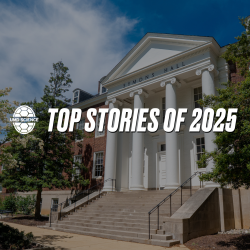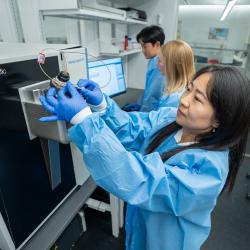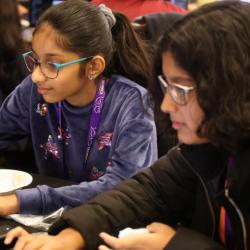Mathematics Professor Abba Gumel Answers Questions About the Math Behind Infectious Disease
The College of Computer, Mathematical, and Natural Sciences hosted a Reddit Ask-Me-Anything spotlighting epidemic modeling research.

University of Maryland Mathematics Professor Abba Gumel participated in an Ask-Me-Anything (AMA) user-led discussion on Reddit to answer questions about the mathematics of infectious diseases on April 9, 2025.
Gumel’s research group develops and analyzes novel mathematical models for gaining insight and understanding of the transmission dynamics and control of emerging and re-emerging infectious diseases of major public/global health significance. Members of Gumel’s lab joined him to answer questions, including postdoctoral researchers Alex Safsten and Arnaja Mitra and visiting assistant research scientist Salihu Musa.
This Reddit AMA has been edited for length and clarity.
My understanding is that diseases tend to spread exponentially in their initial stages. Is this accurate, and/or is it contingent on the disease itself? At what point, if any, does this trend begin to flatten?
(Gumel) That's a great question. Yes, diseases generally spread exponentially during the early stages (particularly if the reproduction number of the disease is greater than 1), and begin to decline as interventions and mitigation measures are implemented or people change their behavior. Most diseases tend to have a single peak and decline to lower or elimination levels with time and as the population of susceptible individuals decreases.
Unfortunately, pandemics of influenza-like illnesses do not have single peaks; they have multiple peaks driven by factors such as human behavior, emergence of new variants, inadequate control resources, and so on.
How integral is an education in bioinformatics/computer science in biological science as it currently stands?
(Safsten) I find the ability to write programs, solve equations that arise in my models of biological problems very helpful. The models I tend to work on have unusual features that cannot be handled by standard equation-solving packages, so I develop my own algorithms for solving these models.
(Gumel) Students of biological sciences should be well-versed in computational and data analysis tools needed for studying the biological systems of interest.
(Musa) Bioinformatics and computer science are now key to biology. Analyzing large-scale data such as genomics, protein structures or disease patterns requires coding, algorithms and data science tools.
If someone were interested in the cross-section of math and biology, what recommendations would you give them to work in the field in the future?
(Safsten) Most people who work in mathematical biology are either very applied mathematicians or very theoretical biologists. I am the former, so I can mostly speak to that career path. I recommend studying differential equations, dynamical systems and linear algebra. You'll also benefit from some programming experience. Then, look into whatever areas of biology interest you. Whatever areas you choose, you will find unanswered questions that can be addressed with mathematical analysis.
(Mitra) If someone is interested in math and biology—especially if looking to switch into the field of epidemiology, systems biology, population dynamics or computational biology—besides having a math background, it will be good to consider some introductory biology, genetics and ecology. Also, if someone has no prior experience in programming languages, you can start with MATLAB or Python for simulation and data analysis. And if you want to do a simple computation, you may choose Mathematica or Maple. If you want to do some statistics modeling, then it's good to have some basic statistics or parameter estimation knowledge.
(Gumel) You're making a good choice to dabble in the beautiful world of mathematics and biology! That's where the real action is. The synergy between mathematics and biology provides exciting new challenges to mathematicians, sometimes requiring the development of new mathematical tools and branches (such as topological data analysis, uncertainty quantification and even nowadays, machine learning and AI tools). In general, to be successful within the space of mathematical biology, one has to have a deep appreciation for both mathematics, biology and all the other tools that are needed to succeed, including statistics, optimization, computation, data analytics, etc.
One also has to have the desire to learn—for example, if you're a mathematician, you have to have the desire and capacity to learn the basic tools in biology to design, analyze and simulate realistic mathematical models for the biological phenomenon being modeled. Likewise, a biologist or someone in other sciences interested in doing modeling should also be comfortable learning the basic mathematical, statistical and computational tools needed to model the phenomenon. You can start with some of the classical literature on the topic, such as this Kermack-McKendrick 1927 paper and Hethcote's Scientific American review.
What is your understanding of the connection between pandemics and their frequency? Is there math backing up why we had so much time between the Spanish flu and the COVID-19 outbreak?
(Gumel) The 1918-1919 influenza pandemic was caused by the H1N1 influenza A virus. We have seen multiple outbreaks of the H1N1 pandemic since the 1918 pandemic, including the 2009 H1N1 swine flu pandemic, which started in Mexico and the United States. On the other hand, COVID-19 was caused by a coronavirus biologically similar to two previous coronavirus pandemics (the SARS pandemic of 2002 and the MERS pandemic of 2012).
Pandemics are generally consequences of spillover events from animals to humans. The frequency depends on the level of interaction between animals and humans. As long as humans continue to encroach on natural habitats of animals and alter or act in ways that affect the natural environment, we are constantly a mutation or two away from a spillover that could lead to a pandemic in humans. Sadly, it's a question of when, not if, we will be hit with the next pandemic (especially of respiratory pathogens).
(Safsten) There is no regular cycle for pandemics, but models show that globalization, urbanization, human action (climate change, land-use changes, etc.) and zoonotic spillovers increase the risk of pandemics.
In hindsight, was the two-week “quarantine to stop the spread” viable, mathematically? What percentage of the U.S. population would’ve needed to cooperate?
(Gumel) It's true that quarantine of symptomatic people for two weeks (away from interaction with the general population) will be useful in curtailing the spread of the disease, since the two-week quarantine period matches the incubation period of the disease.
The big problem with COVID is that many of the transmitters are asymptomatic and have no idea they have the disease. Therefore, they are not in quarantine. In that sense, COVID-19 is different from other diseases where the main transmitters are people with symptoms. Because of that, quarantine and isolation alone are not sufficient to effectively mitigate or control the disease. For COVID, we needed a hybrid strategy that involved quarantine, large-scale testing, contact tracing, use of face masks and pharmaceutical interventions such as the vaccine and monoclonal antibody treatments.
Beyond explaining the mathematics behind it all, what are the most challenging obstacles you face when communicating your findings to public health professionals/policymakers?
(Gumel) Mathematics doesn't always have all the answers. Models are built based on well-thought-out assumptions, and predictions are subject to all sorts of uncertainties in the data, the assumptions, etc. It's very difficult to communicate these facts to public health professionals who are expecting actionable, day-to-day predictions. One of the things that seems to be missing in the modeling/science curriculum in general is how to effectively communicate our results and outputs of our modeling work to the general population. COVID-19 has highlighted the need for incorporating effective communications into science curricula in general, and the modeling of infectious diseases in particular.
What type of mathematical operations and theorems are you using for this research?
(Gumel) We generally design, calibrate, analyze and simulate various types of models (mechanistic/compartmental, network, statistical and some use AI/ML and agent-based models) to study the transmission dynamics and control of infectious diseases. We develop and use tools for nonlinear dynamical systems and other branches of mathematics to study the asymptotic properties of the steady-state solutions of the model, and characterize the bifurcation types (these allow us to obtain important epidemiological thresholds that are associated with the control or persistence of the disease in a population (such as the basic reproduction number and herd immunity thresholds). We also use statistical and optimization tools to fit models to data (and to estimate unknown parameters) and conduct uncertainty quantification and sensitivity analysis. Specifically, we use tools like Latin Hypercube Sampling and Partial Rank Correlation Coefficients to carry out global uncertainty and sensitivity analysis. Finally, we use these tools to determine optimal solutions, particularly when control resources are limited.
(Safsten) The models we use typically take the form of deterministic or stochastic systems of nonlinear differential equations that could be ordinary or partial (where the models have several other independent variables in addition to time). In the case of partial differential equations (PDEs), the models often take the form of semi-linear parabolic equations for which there are many analytical tools for analyzing the existence, uniqueness, boundedness and asymptotic stability of solutions. When external factors, such as climate change, behavior change, and gradual refinement of interventions, affect the system in a time-dependent way, the resulting models are non-autonomous. And there are very few theoretical tools for analyzing these models (for special cases, for instance, where the time-dependent parameters are periodic), thereby providing ample opportunities for aspiring graduate students to consider for their dissertations.
What are the most surprising factors that you found for diseases spreading?
(Mitra) One of the factors I found in my ongoing research is that the nonlinear effect of human behavior changes in one age group can significantly affect the transmission dynamics in another. For instance, even a tiny shift in behavior, such as reducing bednet use among children or a decrease in vaccine uptake, can lead to a disproportionate increase in disease transmission at the population level. Moreover, maturation can create a shift in the susceptible population, spatially in models where vaccine-induced immunity wanes over time.
(Gumel) Most human diseases are zoonotic diseases that jump from animal populations to humans; we humans are responsible for most of these diseases based on our actions that affect the natural habitats and dynamics of nonhuman primates. Understanding the One Health approach to public health—where public health is viewed holistically from the point of view of nonhuman primates, humans and the environment—is so critical to improving human health.
The other surprising thing is the role of the asymptomatic and presymptomatic transmission in the spread and control of COVID-19 (before COVID, diseases were mostly transmitted by people with clinical symptoms, not largely by those without symptoms).
While some diseases are controllable using basic public health measures such as quarantine, isolation and hand-washing (e.g., SARS of 2002-2003 and even MERS of 2012), others require the use of both non-pharmaceutical and pharmaceutical interventions (e.g., COVID-19).
(Musa) In addition to asymptomatic transmission of infectious diseases (such as COVID-19), there were also superspreading events where a small number of individuals affected an unusually large number of others. See our paper on modeling superspreading of COVID. This dynamic made surveillance, contact tracing and control of COVID-19 more difficult.







